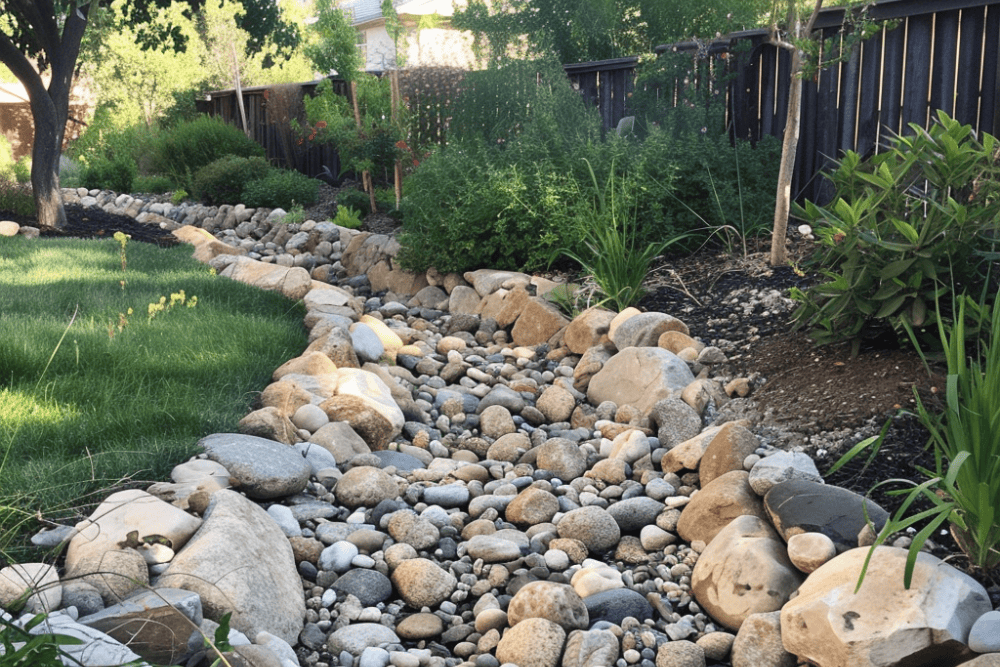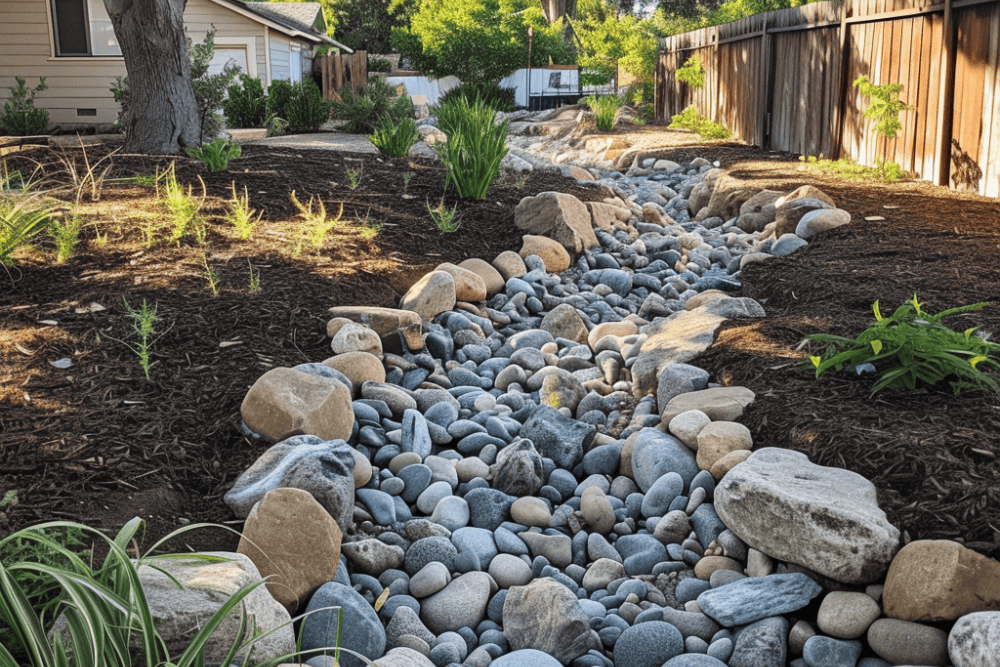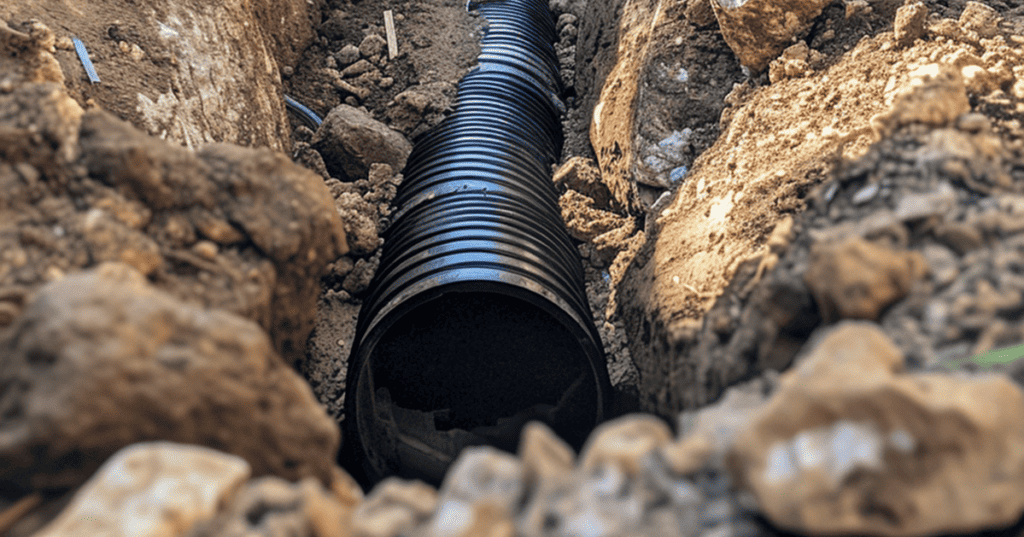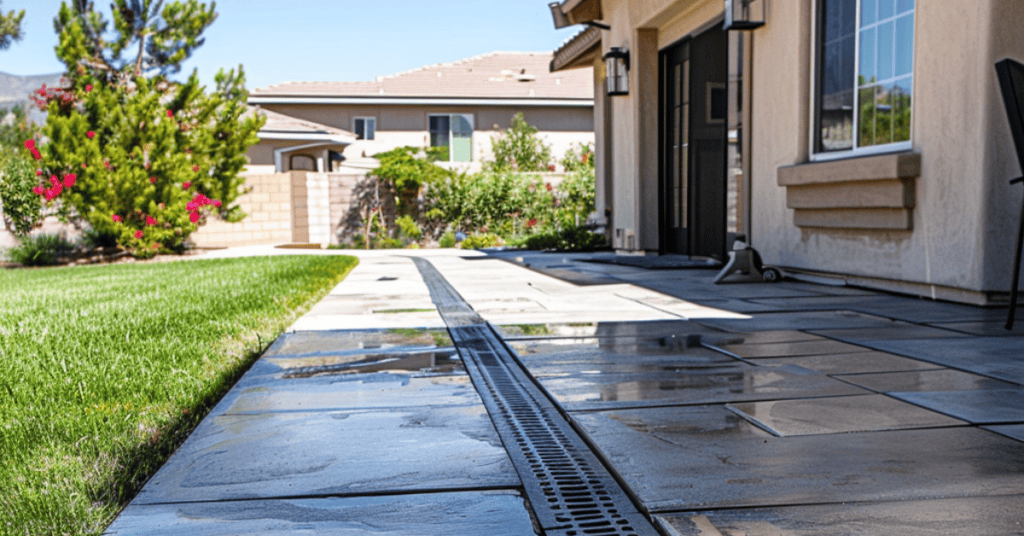The Importance of Rocks for Proper Landscaping Drainage
The Best Drainage Rocks for French Drains
Types of Rocks for Drainage
Proper drainage in landscaping keeps your garden healthy. It prevents water pooling and soil erosion. Good drainage ensures water flows away quickly from your plants and structures. Choosing the right rock can affect water flow and help prevent soil erosion. Here are three types of rocks you should consider for drainage.
Gravel
Gravel is a popular choice for drainage systems. It consists of small, loose pieces of rock. Pea gravel is one type of gravel often used because its smooth, rounded nature allows for easy water flow. It typically comes in multiple colors, including brown, blue, and grey. The color isn’t all that important as the pea gravel will be surrounding the drain pipe and be covered by sod.
Pea gravel requires a layer of gravel at least a few inches thick to be effective. This helps to keep the area well-drained and prevents water from pooling. Gravel is usually quite affordable and can be found at most home improvement stores. Pea Gravel is the go to option for french drains.
River Rocks
River rocks are another good option for drainage. These rocks are larger and smoother than other rocks. Their size can vary, but they are generally around 1 to 5 inches. River rocks can be used to create a decorative, yet functional, drainage system.
The smooth texture of river rocks helps water flow easily, reducing the risk of flooding. These rocks come in various colors and can add visual appeal to your landscaping. Like gravel, a layer of river rock can assist in keeping areas dry and free from excess water buildup.
While not typically used for french drains, river rocks are frequently used in areas where water drains. The rocks are able to protect underlying soil and slow down the draining water which can help to mitigate erosion issues. 
A mix of Different Types of Rocks – Including River Rocks, Boulders and Crushed Stone in a Dry Creek Bed
Crushed Stone
Crushed stone is highly effective for drainage purposes. This type of gravel features angular, rough pieces that lock together. This structure allows water to pass through while providing a stable base. Crushed stone can vary in size, making it suitable for different types of drainage projects.
Crushed stone also creates a firm base that can support other materials or soil layers. It is often used as a base layer under driveways and pathways to enhance drainage. This rock’s rough texture ensures that water flows through without much resistance. Crushed stone is versatile and comes in a range of sizes and colors to fit your specific needs.
Installation Techniques
Proper installation of drainage systems improves water management in your yard. Choose the right rock and method for your needs. Here are some effective techniques.
Creating a French Drain
To create a French drain, start with a trench about 12 inches wide and 18-24 inches deep. Ensure the trench slopes around one inch for every 10 feet. This helps the water to be effectively whisked away.
Use a perforated pipe. The holes in the pipe collect water from the soil and channel the water to where it can be safely deposited without causing damage to your property or neighboring properties. The pipe itself is surrounded by a mesh “sock”. This sock allows water to enter into the holes in the pipe, but it does a great job of keeping debris and sediment out of the pipe.
Completely surround the pipe on all sides with at least 2 inches of the pea gravel. Then cover the remaining area with topsoil and mulch for a neat appearance.
Building Dry Creek Beds
A Dry Creek Bed in a Low Lying Area Will Collect Excess Water and Move it Away From Your Property
Dry creek beds combine function and beauty. They resemble a natural stream but manage water flow effectively.
This creek bed should be installed along the natural contour of your yard – where water tends to collect and drain out. You could also dig a shallow trench along the desired path. The trench should be roughly 6 inches deep for a small creek bed. You’ll want to make sure that your creek bed has a proper slope. Aim for at least an inch of drop every 10 feet or so.
Next, Lay larger river rocks along the channel center. This creates the bed’s main structure. Add smaller stones on the sides. This helps simulate a natural look. Place flat stones on the edges to prevent soil from washing in. Alternatively, you can use landscape edging to keep the dry creek bed structure intact and avoid the effects of shifting soils.
Mix in some pea gravel for a smooth finish. Ensure the creek bed slopes downward. This helps direct water away from structures. Fill any remaining gaps with river rock or another type of inorganic mulch. This enhances both drainage and appearance.
Drainage for Specific Areas
Different areas require different types of rocks for effective drainage. It’s important to choose the right material to prevent water damage and ensure proper water flow.
Garden and Flower Beds
In gardens and flower beds, proper drainage prevents waterlogging, which can harm plants. Roots that get too wet can rot and damage and even kill the plants. Pea gravel works well here. It’s smooth and round, allowing water to flow through easily. This gravel also adds to the aesthetics of your garden.
For added drainage, consider using crushed stone or angular rocks. These materials provide excellent water flow and keep your plants’ roots from sitting in water. Combine gravel with soil amendment to improve overall drainage.
Foundations and Basements
Preventing water damage around your home’s foundation and basement is crucial. Crushed stone, also known as angular stone, is ideal for this purpose. Its rough texture helps improve water flow, diverting it away from the foundation.
A downspout rock drain directs water effectively while protecting your basement from leaks. For deeper trenches around the foundation, choose larger stones. Larger stones help disperse water and reduce pressure on the building foundation.
Oftentimes the installation of a French Drain along your foundation is the best solution to keep water away from your basement.
Driveways and Pathways
For driveways and pathways, proper drainage is key. Crushed granite and river rocks work well here. They support the weight of vehicles and prevent pooling water. For better traction, use angular gravel or crushed stone.
If you have concrete or asphalt driveways, adding rocks along the edges can enhance yard drainage. Larger rocks help manage water flow and protect the driveway from erosion. This prevents water from seeping into cracks, which can cause damage over time.
Choosing the right type of rock based on your specific area ensures effective water management and enhances the functionality and aesthetics of your space.
Preventing and Resolving Drainage Issues
Effective drainage solutions involve the right materials and techniques. Using rocks and other methods can control erosion, manage water accumulation, and enhance soil permeability.
Erosion Control
Rocks play a key role in preventing erosion. Placing them in low-lying areas or on slopes helps keep soil in place. The rocks also slow down the rushing water – which dissipates the energy of the water and mitigates the effects of erosion.
Gravel and pebbles are useful options. They create barriers that slow down water flow. Larger rocks like boulders can also protect against heavy rain.
Using rocks also protects plant roots. Without erosion control, roots may become exposed and vulnerable. This can lead to root rot and weakened plants. To make the most of these benefits, always ensure rocks are firmly set in the ground to avoid shifting.
Managing Water Accumulation
Proper drainage keeps water away from your home. Rocks like crushed stone provide a firm layer that lets water pass through. This helps avoid standing water, which can lead to mosquito breeding and root rot. This also reduces the chance of flooding during heavy rains.
Pea gravel and river rock are both effective for managing water. They promote quick water absorption and reduce perched water tables. For best results, use a mix of different sizes to improve drainage. Make sure to check and clear any debris that can block water flow.
Enhancing Soil Permeability
Good soil permeability means water drains quickly and doesn’t stay on the surface. Adding rocks to the soil mix improves this property. Vermiculite and perlite can also enhance permeability. Mixing these materials with soil increases the gaps through which water can pass.
Improved soil drainage helps plants thrive. It prevents too much water from drowning plant roots. To further boost soil quality, consider adding compost or potting mix. This mix ensures plants get the nutrients they need without excess water buildup. Using rocks with these materials creates an environment where plants can grow healthily.
Maintenance and Improvement
Believe it or not, even with rocks that are used for drainage, there are some maintenance tasks to ensure that the rocks allow water to drain properly. Remove debris like leaves and twigs from your yard drain. This keeps water flowing smoothly. Clear out any sediment build-up in your ditches or swales.
Inspect your drainage rocks at least once a year. Look for signs of clogging or shifting. Adjust or reseat rocks as needed. Consistent checks help prevent larger issues.
Consider adding more rocks if your region receives heavy snow or rainfall. This improves water management. Larger rocks, like crushed stone, can offer better support. Weed your drainage areas to prevent organic matter (like dirt and leaves) from accumulating within your drainage system and hampering its effectiveness.


